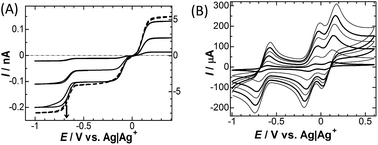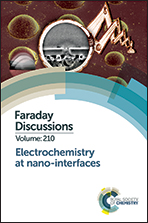Effects of the dipolar double layer on elemental electrode processes at micro- and macro-interfaces
Abstract
Determination of heterogeneous rate constants of redox reactions or charge transfer resistances always involves ambiguities due to their participation in double layer (DL) capacitances and solution resistances. The rate constants determined by steady-state voltammograms at ultra-microelectrodes are inconsistent with time-dependent voltammograms, implying participation of the DL impedance. We examine controlling factors of DLs through the frequency-dependence of the capacitance on the basis of the definition of the current and the capacitance. The capacitance obeys the power law of the frequency. It is controlled by the orientation of a limited amount of solvent dipoles, independent of salts. Redox species, dipoles of which are oriented oppositely to the solvent dipoles, decrease the DL capacitance and make the value negative at high concentrations of the species. The decrease in the capacitance increases the real impedance, as predicted from the phase angle, yielding an extra resistance. This may be a ghost charge transfer resistance. However, there are actually a number of well-defined charge transfer resistances, which are observed as transferring rates through films on electrodes.

- This article is part of the themed collection: Electrochemistry at nano-interfaces


 Please wait while we load your content...
Please wait while we load your content...